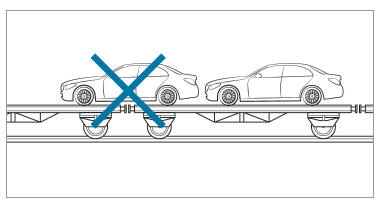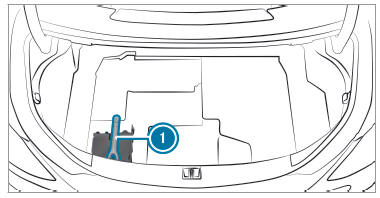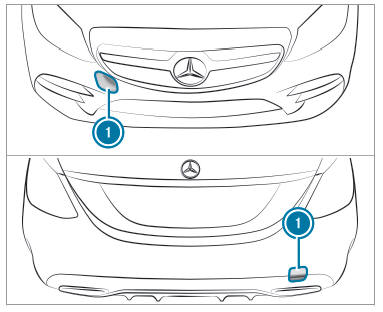Permitted towing methods
Mercedes-Benz recommends transporting your
vehicle in the case of a breakdown, rather than
towing it away.
For towing, use a tow rope or tow bar with both
axles on the ground. Do not use tow bar systems.
| NOTE Damage to the vehicle due to towing
away incorrectly |
- Observe the instructions and notes on
towing away.
|
Permitted towing methods
| Vehicle equipment/towing
method |
 Both axles on the
ground |
 Front axle raised |
 Rear axle raised |
| Vehicles with automatic transmission |
Yes, maximum 31 miles (50 km) at
31 mph (50 km/h) |
No |
Yes, if the steering wheel is fixed in
the center position with a steering
wheel lock. |
| 4MATIC vehicles |
Yes, maximum 31 miles (50 km) at
31 mph (50 km/h) |
No |
No |
Towing with a raised axle: towing should be
performed by a towing company.
Towing the vehicle with both axles on the
ground
Observe the following points when the battery is
discharged:
-
The engine cannot be started
-
The electric parking brake cannot be
released or applied
-
Vehicles with automatic transmission:
The automatic transmission cannot be shifted
to position N or P.
Vehicles with automatic transmission: If
the automatic transmission cannot be shifted
to position N, or the multifunction display
in the instrument cluster does not show
anything, have the vehicle transported away. A towing vehicle with lifting
equipment is required for vehicle transportation.
| NOTE Damage due to towing away at
excessively high speeds or over long distances |
The drivetrain could be damaged when towing
at excessively high speeds or over long
distances.
- A towing speed of 30 mph (50 km/h)
must not be exceeded.
- A towing distance of 30 miles (50 km)
must not be exceeded.
|
| WARNING Risk of accident when towing
a vehicle which is too heavy |
If the vehicle being tow-started or towed
away is heavier than the permissible gross
mass of your vehicle, the following situations
can occur:
- The towing eye may become detached.
- The vehicle/trailer combination may
swerve or even overturn.
- If another vehicle is tow-started or
towed away, its weight must not exceed
the permissible gross mass of your own
vehicle.
|
If a vehicle must be tow started or towed away,
its permissible gross mass must not exceed the
permissible gross mass of the towing vehicle.
-
Information on the permissible gross mass of
the vehicle can be found on the vehicle identification
plate .
-
Vehicles with automatic transmission: Do
not open the driver's door or front passenger
door, otherwise the automatic transmission
automatically shifts to position P.
-
Installing the towing eye .
-
Fasten the tow bar.
| NOTE Damage due to incorrect connection |
- Only connect the tow rope or tow bar to
the towing eyes.
|
-
Deactivating the automatic locking mechanism.
-
Do not activate the HOLD function.
-
Deactivate Active Brake Assist.
-
Vehicles with automatic transmission:
Shift the automatic transmission to position
N.
-
Release the electric parking brake.
| WARNING Risk of accident due to limited
safety-related functions during the
towing process |
Safety-related functions are limited or no longer
available in the following situations:
- the ignition is switched off.
- the brake system or power steering system
is malfunctioning.
- the energy supply or the on-board electrical
system is malfunctioning.
When your vehicle is then towed away, significantly
more effort may be required to steer
and brake than is normally required.
- Use a tow bar.
- Make sure that the steering wheel can
move freely, before towing the vehicle
away.
|
| NOTE Damage due to excessive tractive
power |
If you pull away sharply, the tractive power
may be too high and the vehicles could be
damaged.
- Pull away slowly and smoothly.
|
Loading the vehicle for transport
-
Observe the notes on towing away.
-
Connect the tow bar to the towing eye in
order to load the vehicle.
-
Vehicles with automatic transmission:
Shift the automatic transmission to position
N.
Vehicles with automatic transmission:
The automatic transmission may be locked
in position P in the event of damage to the
electrical system. To shift to N, provide the
on-board electrical system with power.
-
Load the vehicle onto the transporter.
-
Vehicles with automatic transmission:
Shift the automatic transmission to position
P.
-
Use the electric parking brake to secure the
vehicle against rolling away.
-
Only secure the vehicle by the wheels.
Vehicles with ADS PLUS (Adaptive Damping
System PLUS)
| WARNING Risk of an accident when
transporting vehicles with Adaptive
Damping System PLUS |
| The reduced damping forces on the vehicle
being transported can cause the vehicle/
trailer combination to start to swing.
As a result, when transporting vehicles with
the Adaptive Damping System PLUS, the
vehicle/trailer combination may start to skid.
Consequently, you could lose control of your
vehicle.
- When transporting, ensure that:
- The vehicle has been loaded onto
the transporter correctly
- The vehicle is secured at all four
wheels with suitable tensioning
straps
- The maximum permissible speed of
35 mph (60 km/h) is not exceeded
when transporting
|
| NOTE Damage to the vehicle from securing
it incorrectly |
- After loading, the vehicle must be
secured at all four wheels. Otherwise,
the vehicle could be damaged.
- A minimum distance of 8 in (20 cm) up
and 4 in (10 cm) down must be kept to
the transport platform.
|
4MATIC vehicles/vehicles with automatic
transmission

- Make sure that the front and rear axles come
to rest on the same transportation vehicle
| NOTE Damage to the drivetrain due to
incorrect positioning |
- Do not position the vehicle above the
connection point of the transport vehicle.
|
Towing eye storage location

Towing eye 1 is located in the stowage space
under the trunk floor
Installing the towing eye

- Press the mark on cover 1 inwards and
remove.
- Screw in the towing eye clockwise as far as it
will go and tighten.
Make sure that cover 1 engages in the
bumper when you remove the towing eye.
| NOTE Damage due to incorrect use of
the towing eye |
When a towing eye is used to recover a vehicle,
the vehicle may be damaged in the process.
- Only use the towing eye to tow away or
tow start the vehicle.
|
Tow starting the vehicle (emergency engine
start)
Vehicles with automatic transmission
| NOTE Damage to the automatic transmission
due to tow starting |
The automatic transmission may be damaged
in the process of tow starting vehicles with
automatic transmission.
- Vehicles with automatic transmission
must not be tow started.
|
- Vehicles with automatic transmission must
not be tow-started.
| 







